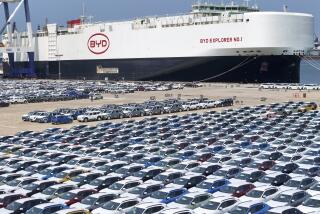World’s cheapest car debuts
NEW DELHI — India’s Tata Motors Ltd. unveiled the world’s cheapest car Thursday, bringing car ownership closer for millions of poor consumers in emerging markets but raising environmental concerns.
The four-seater Nano will have a dealer price of 100,000 rupees ($2,500), about half the cost of the cheapest car on today’s market, a 25-year-old model from Tata’s great rival, Maruti Suzuki Ltd., also based in India. The Nano will go on sale this year, the company said.
“Let me assure you and our critics the car we have designed will meet all safety norms and all foreign environmental criteria,” Chairman Ratan Tata said as he unveiled what had been dubbed “the people’s car” at the Auto Expo in New Delhi.
“In a way, it is a high point for me. There is a sense of achievement and vindication,” he later told reporters.
The compact but curvy Nano stands in sharp contrast to the luxury Jaguar and Land Rover brands that Tata is negotiating to acquire from Ford Motor Co.
Hundreds of people crowded into the pavilion to see the long-awaited launch, standing on chairs to get the best view as Ratan Tata introduced and then drove the car onto the stage in a media circus more worthy of a pop concert or an Oscar ceremony.
Tata planned the car years ago as a safer and more affordable alternative for the millions of people who often ferry families of four, plus baggage, on motorbikes and scooters.
“It’s a dream come true,” Ashok Singh, a constable with the Delhi Police, said at the show. “I look forward to buying that car. My wife will be really happy.”
New cars are preferable to buyers in India, where the absence of an organized market for secondhand cars makes buying them a tedious and sometimes risky process.
Environmentalists are not so enthusiastic. They worry that millions of the cheap cars will flood India’s roads, many of which are already heavily congested, sending emissions levels sky-high in Asia’s third-biggest economy.
The car arrives at a time when oil is selling near $100 a barrel, the move to fuel-efficient cars is gaining momentum, and a wave of nostalgia has spurred sales of brands such as BMW’s Mini and the Fiat 500 Cinquecento.
The car has a rear-mounted gasoline engine and travels about 50 miles per gallon, with a basic model and two deluxe variants and plans for diesel versions.
“The proof of the pudding will be in driving it, but visually it looks pretty good,” said London-based auto analyst Ashvin Chotai, who was at the unveiling.
Tata said costs were kept low by cutting the size of the package, which brought about a reduction in material. Innovative processes and systems, for which the firm has filed 33 patents, also helped.
Chotai said deluxe variants, including features such as air conditioning, would account for the bulk of sales. Tata expects the car to sell well in semi-urban and rural areas as well as India’s cities.
“Margins are still going to be very, very thin,” Chotai said.
--
(BEGIN TEXT OF INFOBOX)
The Nano vs. the Model T
How two pivotal vehicles, introduced a century apart, stack up.
Tata Nano
Introduced: 2008
Cost: $2,500
Horsepower: 33
Cylinders: 2
Top speed: 60 mph
Miles per gallon: 50
Seating capacity: 4 or 5 adults
Seat belts: Yes
Air bags: No
Radio: No
Air conditioning: No
Windshield wipers: 1
--
Ford Model T
Introduced: 1908
Cost: $850 (about $19,000 today)
Horsepower: 20
Cylinders: 4
Top speed: 45 mph
Miles per gallon: 13 to 21
Seating capacity: 6 or 7 adults
Seat belts: No
Air bags: No
Radio: No
Air conditioning: No
Windshield wipers: None






